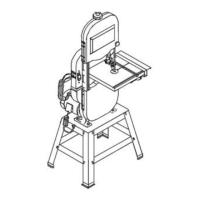To avoid injury, turn the switch OFF and disconnect the
saw from the power source before making any
adjustments. NEVER make tension adjustments with the
The gauge (1) on the bracket (2) at the rear of the upper
wheel housing indicates the proper tension for the
Set the blade tension gauge to correspond with the
width of the blade in use.
Turn the blade tension knob (3) clockwise, raising
the upper wheel to tighten the blade. Turn the knob
counterclockwise to lower the upper wheel,
3. As you become familiar with the saw, you may want
to change the tension settings.
Changes in blade width and type of material
being cut will have an effect on the blade tension.
Too much or too little tension could break the blade.
When the band saw is not in use, relax the blade
To avoid injury, turn the switch OFF and unplug the
saw from the power source before making any
TABLE ADJUSTMENTS (FIG. J, K)
Tilting the table (Fig. J)
The band saw table (1) tilts 0° to 45° right
1. Loosen both table lock knobs (2) underneath the
2. Tilt the table to the desired angle on the scale (3)
3. Tighten the two table lock knobs.
ADJUSTING THE 90° TABLE STOP
1. Loosen the table lock knobs (2) and tilt the table to
2. Loosen the nut (4) on the table stop bolt (5) and
lower the stop bolt as far as possible.
3. Tilt the table until rests on the stop bolt.
4. Place a combination square (6) on the table with the
heel of the square against the saw blade
5. Adjust the tilt of the table left or right until it is 90°
to the blade. Make sure there is no space between
the square and the blade. Tighten the table lock
6. Adjust the table stop bolt up until it touches the table.
7. Loosen the lock knobs and see that the table is
resting on the stop bolt.
8. Check the square to make sure the table is still
square to the blade. If not, readjustment the stop
9. When the adjustment is accurate at 90°, align the
pointer (7) to 0° the scale (8).

